OMNIA.11 Processador de Áudio
Processador de Áudio OMNIA.11
Processamento FM de classe emblemática para as emissoras mais competitivas do planeta.
- DESCRIÇÃO
- CARACTERÍSTICAS
- ESPECIFICAÇÕES
- DOWNLOADS
- GARANTIA
- Informação adicional
- Avaliações (0)
OMNIA.11 OVERVIEW
O Omnia.11 está disponível em FM+HD com caminhos de processamento separados para FM ou HD/DRM e FM sem HD/DRM. O modelo somente FM pode ser atualizado para FM/HD posteriormente. A tecnologia Switchable Single Sideband Suppressed Carrier (SSBSC) para redução potencial de multipath é um recurso padrão. Uma GUI de tela sensível ao toque no painel frontal, em uma tela diagonal de 10,5″, oferece facilidade de uso, medição e diagnóstico aprimorados. O acesso remoto está disponível através de qualquer navegador da Web. Livewire, E/S digital e analógica AES/EBU são padrões. Refrigeração sem ventilador. Chassi robusto de 4 RU.
Os Omnia.11s agora são fornecidos com o padrão G-Force Dynamics Engine. O G-Force também está disponível como um plug-in opcional para unidades Omnia.11 já em campo. Projetado por Frank Foti e Cornelius Gould, o Omnia.11 com G-Force representa uma atualização significativa na dinâmica do Omnia.11 — tão significativa, na verdade, que o Omnia atualizou a GUI para um azul-cobalto vívido. Ele soa ainda melhor do que parece graças a uma estrutura de processamento dinâmico que permite ao Omnia.11 definir o EQ geral para consistência de assinatura, tornando o som mais limpo, claro, mais alto, mais consistente, mais aberto e mais agradável. Você ouve a música. Você ouve a voz. Você não ouve o processador. Os modelos FM+HD e somente FM podem ser atualizados com o plug-in Perfect Declipper opcional, um novo algoritmo revolucionário projetado pela lenda do processamento de áudio Hans van Zutphen que restaura áreas cortadas em gravações de áudio. Este algoritmo não apenas restaura a dinâmica, mas remove a distorção.
Turbine seu som Omnia.11 com G-Force e os plug-ins opcionais Perfect Declipper.
OMNIA.11 FEATURES
Motor Dinâmico G-Force™
O G-Force Plug-In (que é fornecido como padrão em todas as novas unidades Omnia.11 e pode ser adicionado como uma atualização opcional para unidades existentes no campo) permite que o Omnia.11 lide com materiais de origem hipercomprimidos e em rápida mudança melhor do que nunca com melhorias novas e sofisticadas. A estrutura de processamento dinâmico G-Force permite que o Omnia.11 defina o EQ geral para consistência de assinatura, tornando o som mais limpo, mais claro, mais alto, mais consistente, mais aberto e mais agradável. Você ouve a música. Você ouve a voz. Você não ouve o processador.
Tosquiadeira “Pepino”
O mais recente cortador de FM final de Frank Foti, projetado sob medida para levar a G-Force Dynamics ao próximo nível. Inclui “Pepino Clipper Mode 2”, que preserva o brilho em níveis de corte agressivos
Aprimorador de detalhes transitórios
Na seção de dinâmica – controle RMS mais inteligente e mais poderoso nos AGCs, produzindo um aumento sólido e estável no volume para combinar com o desempenho do Pepino.
Plexo solar
Para graves profundos e firmes que você pode sentir!
Aparador de graves unificado FM/HD
- Melhora a consistência de áudio entre os canais FM e HD e a qualidade geral dos graves;
- 1 mais alto para ganhar esse db extra de volume.
Sistema Limiter Inteligente Ultra-Multibanda
As funções de ataque/liberação auto-ajustáveis garantem música e voz cristalinas. Os limitadores são auto-adaptáveis e podem se ajustar à atividade da seção AGC em tempo real, fornecendo uma ação de limitador mais poderosa e transparente do que antes. Facilita o ajuste dos limitadores!
Gerenciamento de graves
Gerencia harmônicos para uma extremidade inferior natural e sem distorções.
Sistema de Clipper Controlado por Distorção Ultra LoIMD
Reduz drasticamente a distorção de intermodulação (IMD) para mais headroom de volume.
Banda base composta MPX sobre AES (Omnia Direct)
A saída do gerador estéreo do Omnia.11 pode ser acoplada diretamente ao modulador do excitador do transmissor. Isso permite que o excitador modular com mais precisão e clareza.
Plug-in do Perfect Declipper (opcional)
Um novo algoritmo revolucionário para restaurar segmentos cortados e remover distorções em gravações de áudio masterizadas agressivamente resulta em uma textura mais clara e aberta que também oferece mais flexibilidade nas opções de processamento. (Deve estar executando v3.0 e G-Force.)
Tecnologia SSBSC
A tecnologia Omnia.11 Single Sideband Suppressed Carrier (SSBSC) pode reduzir a distorção multipath.
Tela sensível ao toque extra larga
A tela diagonal de 10,5″ mostra claramente todos os controles.
Parece legal e permanece legal
O design industrial sem ventoinha de nível militar permanece frio com dissipadores de calor em chassi robusto.
Predefinições
Sempre atualizando, sempre evoluindo, os engenheiros da Omnia estão constantemente se esforçando para fornecer presentes novos e poderosos. Dos melhores ouvidos do setor, encontre seu som personalizado com mais facilidade do que nunca.
OMNIA.11 ESPECIFICAÇÕES
Em geral
- Crosstalk não linear: > -80 dB, principal para sub ou sub para canal principal (referenciado a 100% de modulação);
- 38 kHz Supressão: > 70 dB (referenciado a 100% de modulação);
- 76 kHz Supressão: > 80 dB (referenciado a 100% de modulação);
- Proteção do piloto: > -65 dB em relação a 9% de injeção do piloto, ± 1 kHz;
- 57 kHz (RDS/RBDS) Proteção: melhor que -50 dB;
- Conectores: Dois BNC fêmea com supressão de EMI, flutuando sobre o aterramento do chassi;
- Capacitância de carga máxima: 5nF (com impedância de fonte de 10 ohms);
- Comprimento máximo do cabo: 100 pés/30 metros RG-58A/U.
Entrada de áudio analógica
- Estéreo esquerdo/direito. Equilibrado eletronicamente;
- Impedância de entrada 10k ohms resistiva;
- Nível máximo de entrada: +22 dBu;
- Nível de entrada nominal: +4dBu, que gera uma leitura do medidor de entrada de -18dBFS em um sinal de estado estacionário quando o controle de ganho de entrada está definido para 0,0dB. O material do programa com um nível médio nominal (leitura VU) de +4dBu normalmente produzirá leituras de pico no medidor de entrada na faixa de -12 dBFS a -6dBFS. Este é o nível operacional correto.
Conversão A/D
- Crystal Semiconductor CS5361, conversor delta-sigma sobreamostrado de 24 bits 128x com filtro anti-aliasing de fase linear. Filtro pré-ADCanti-alias, com filtro passa-altas a <10 Hz;
- Conectores: Dois, fêmea XLR com supressão de EMI. Pino 1 terra do chassi, Pino 2 “Quente”.
Saída de áudio analógica
- Estéreo esquerdo/direito. Equilibrado eletronicamente;
- Impedância de saída 20 ohms;
- Impedância de carga mínima: 600 ohms;
- Nível de saída ajustável de -2 dBu a +22dBu de pico em passos de 0,1dB.
Conversão D/A
- Crystal Semiconductor CS4391, 24 bits, 128x oversampled;
- Conectores: Dois, macho XLR com supressão de EMI. Pino 1 terra do chassi, Pino 2 “Quente”.
Resposta de Frequência
- Está em conformidade com a curva de pré-ênfase padrão de 50 ou 75 microssegundos dentro de ± 0,5 dB, 30 Hz a 15 kHz. A saída analógica esquerda/direita e as saídas digitais AES/EBU podem ser configuradas para saída plana ou pré-enfatizada.
Distorção do sistema
- Menos de 0,01% THD, 20 Hz – 7,5 kHz. A distorção do segundo harmônico acima de 7,5 kHz não é audível no sistema FM;
- Relação Sinal-Ruído: > -80 dB sem ênfase, largura de banda de 20 Hz – -15 kHz, referenciada a 100% de modulação;
- O piso de ruído medido dependerá das configurações dos controles de ganho de entrada e saída e é governado principalmente pela faixa dinâmica do conversor A/D Crystal Semiconductor CS5361 que é especificado como >110 dB. A faixa dinâmica da cadeia de processamento de sinal digital interno é >144 dB.
Separação estéreo
- Maior que 65 dB, 20 Hz – -15 kHz; 70 dB típico.
Crosstalk
- > -70 dB, 20 Hz — 15 kHz.
Latência do sistema
- 36-50ms dependendo do processamento e seleção do clipper através do canal “FM”, medido a partir das entradas analógicas através da saída MPX composta.
Saídas compostas
- Impedância da fonte: 5 ohms ou 75 ohms, selecionável por jumper. Extremidade simples e flutuante sobre o solo do chassi. Nível de saída: 0V a 10V em etapas de 0,05V, ajustável por software.
- Composto digital “Omnia Direct” sobre AES3, 192 kHz, 24 bits XLR-macho, com supressão de EMI. Pinos 1 terra do chassi, pinos 2 e 3 do transformador isolados, balanceados e flutuantes. Impedância de fonte de 110 ohm especificada AES3 padrão.
Conversão D/A
- Texas Instruments/Burr Brown PCM1798, conversor sigma-delta de 24 bits.
Configuração
- Duas saídas eletricamente independentes. Ajuste de nível baseado em software.
Impedância de carga
- Sugere-se uma carga de 50 ohms ou superior.
Nível Piloto
- Ajustável de 4,0% a 12,0% em passos de 0,1% e OFF.
Estabilidade do Piloto
- 19 kHz, ± 0,5 Hz.
A relação sinal-ruído
- -85 dB típico, 75 μs sem ênfase, largura de banda de 15 kHz, referenciado a 100% de modulação).
Distorção
- < 0,02% THD 20 Hz – 15 kHz de largura de banda, 75 μs sem ênfase, referenciado a 100% de modulação;
- Separação estéreo: > 65 dB, 30 Hz – 15 kHz;
- Linear Crosstalk: > -80 dB, principal para sub ou sub para canal principal, referenciado a 100% de modulação.
Conector
- XLR-fêmea, com supressão de EMI. Pino 1 terra do chassi, pino 2-3 transformador isolado, balanceado e flutuante. Impedância de entrada balanceada de 110 ohms especificada AES3 padrão.
Faixa de sincronização externa:
Aceita automaticamente taxas de amostragem entre 32kHz e 96kHz. Conector: XLR-fêmea, EMI-suprimido. Pinos 1 terra do chassi, pinos 2 e 3 isolados do transformador, balanceados e flutuantes – impedância padrão AES3 de 110 ohms.
Controle remoto:
Via Ethernet usando o programa de controle remoto baseado em Java (TM) integrado à interface da página da web. Todo o software é servido a partir do servidor web integrado para qualquer navegador web padrão; não há nada para instalar no computador do usuário.
Conectores:
Ethernet – Conector RJ-45 com supressão de EMI padrão da indústria.
Interface GPI:
- Conector: conector fêmea DB-15 com supressão de EMI;
- Requerimentos: 100-250 VCA, 47-63 Hz, Típico: 65 W RMS, Máx.: 90 W RMS
Conector de força:
EMI suprimiu IEC masculino. Cabos de alimentação de 3 fios destacáveis fornecidos para uso nos EUA e na Europa.
Fonte de energia:
- Interno.
- Proteção contra sobretensão e curto-circuito.
Entrada de áudio digital:
- Configuração: Estéreo por padrão AES/EBU, Transceptor de áudio digital CS8420 com resolução de 24 bits, seleção de software de estéreo, mono da esquerda, mono da direita ou mono da soma.
- Aceita e bloqueia automaticamente a entrada de taxas de amostragem entre 30 e 108 kHz.
- Conector: XLR-fêmea, com supressão de EMI. Pinos 1 terra do chassi, pinos 2 e 3 isolados do transformador, balanceados e flutuantes – impedância padrão AES3 de 110 ohms.
Saída de áudio digital nº 1:
- Estéreo por padrão AES3. A saída pode ser configurada em software para resposta plana ou pré-enfatizada em 50 ou 75 microssegundos.
- Taxas de amostragem digital: Software de taxas de amostragem de saída selecionáveis para 48kHz, Sync to Input ou Sync to External.
- Conector: XLR-macho, com supressão de EMI. Pinos 1 terra do chassi, pinos 2 e 3 do transformador isolados, balanceados e flutuantes. Impedância de fonte de 110 ohm especificada AES3 padrão.
- Nível de saída digital: -22,0 a 0,0 dBFS ajustável por software.
Saída de áudio digital nº 2:
- Estéreo por padrão AES3. A saída pode ser configurada em software para resposta plana pré-enfatizada em 50 ou 75 microssegundos.
- Taxas de amostragem digital: Software de taxas de amostragem de saída selecionáveis para 48kHz, 44,1kHz ou Sync to External.
- Conector: XLR-macho, com supressão de EMI. Pinos 1 terra do chassi, pinos 2 e 3 do transformador isolados, balanceados e flutuantes. Impedância de fonte de 110 ohm especificada AES3 padrão.
- Nível de saída digital: -22,0 a 0,0 dBFS ajustável por software.
Entrada de sincronização externa:
- Sincronização Externa: A taxa de amostragem de saída pode ser sincronizada com o sinal presente na entrada AES/EBU ou com um sinal AES3 aplicado à saída Ext. Conector de entrada de sincronização. (Não aceita entradas Word Clock)
Regulatório
América do Norte: testada e compatível com FCC e CE, a fonte de alimentação é aprovada pela UL.
Europa: Em conformidade com a Diretiva da União Europeia 2002/95/EC sobre a restrição do uso de certas substâncias perigosas em equipamentos elétricos e eletrônicos (RoHS), conforme alterada pelas Decisões da Comissão 2005/618/EC, 2005/717/EC, 2005 /747/EC (Diretiva RoHS) e WEEE.
OMNIA.11 EM PROFUNDIDADE
Novo motor dinâmico G-Force™
O G-Force (fornecido como padrão em novas unidades e está disponível como um plug-in opcional para atualizar as unidades de campo existentes) tem um esquema de detecção de densidade altamente refinado, significando desempenho sólido em uma ampla variedade de gravações. Os valores de ataque, liberação e proporção adaptáveis do programa permitem que você defina os elementos característicos do seu som de assinatura e torne a aceleração e desaceleração de áudio mais suaves do que nunca. Um Makeup Threshold permite o gerenciamento e controle de ganho sem oscilações repentinas e audíveis. Além disso, as seções do AGC são sincronizadas com o material do programa. Os limitadores multibanda agora se adaptam automaticamente à atividade do AGC multibanda e também apresentam ataque e liberação controlados por programa, reduzindo ativamente a distorção intermod induzida pelo limitador. Os limitadores são mais responsivos e ativos, mas notavelmente transparentes, mesmo sob atividade extrema. O G-Force requer v3.0, descrito abaixo.
Atualizações de software
O plug-in G-Force é executado no Omnia.11 v3.0 ou posterior. Incluídos nesta versão geral do sistema estão muitas melhorias, incluindo: Static RDS; a flexibilidade de pontos de conexão analógicos, AES/EBU ou Livewire; localização do ponto de patch para cadeias PPM® para você poder integrar seu combo Voltair/Encoder em sua cadeia de processamento de áudio; medidores de entrada e saída de pontos de patch para referências fáceis de nível; controle subharmônico superior do Plexo Solar sobre o equilíbrio tonal; e compatibilidade com sistemas de alinhamento de tempo FM-HD de terceiros. Um EQ paramétrico incluindo lo e hi shelf substitui a seção do mixer limitador na cadeia de processamento HD, adicionando compatibilidade com a nova localização do ponto de patch para maior flexibilidade. Você pode selecionar se o processamento HD é alimentado com o sinal que passa pelo ponto de patch ou não, permitindo a marca d’água PPM® separada dos lados HD/digital. Finalmente, todos os controles de nível “Master” de entrada e saída agora se ajustam em passos de 0,1 dB, com um modo “acelerador” dando passos de 0,5 dB. A V3.0 também permite que você demonstre o plug-in G-Force sem compromisso.
A versão 3.6 também já está disponível, com muitas melhorias em relação à v3.0, incluindo o novo clipper “Pepino” agora com dois modos. Melhorias no processamento G-Force para tirar proveito do clipper recém-projetado. Manipulação de alta frequência aprimorada e resposta de graves mais consistente. “Transient Detail Enhancer” na seção de dinâmica com controle RMS mais inteligente e poderoso nos AGCs, produzindo um aumento sólido e estável no volume para combinar com o desempenho do Pepino. Comutação mais suave entre predefinições. O Unified FM/HD Bass Clipper melhora a consistência de áudio entre os canais FM e HD e a qualidade geral dos graves. Nova atualização Phat Bass para uma presença de graves mais rica e forte. Som aprimorado na seção de DJ de baixo atraso. Limitador de antecipação de HD bastante aprimorado em unidades habilitadas para HD. Voz de DJ ao vivo mais quente e limpa.
A opção de plug-in declipper perfeita
Quando você pensava que nada poderia soar melhor, os Omnia.11s habilitados para G-Force podem ser atualizados com o Perfect Declipper Plug-In. Projetado pela lenda do processamento de áudio Hans van Zutphen, o Perfect Declipper usa um novo algoritmo revolucionário para substituir áreas cortadas em gravações de áudio, restaurando a dinâmica e removendo a distorção. Você deve estar executando v3.0 e G-Force para instalar o plug-in Perfect Declipper.
Sistema Limiter Inteligente Ultra-Multibanda
A tecnologia de limitação tradicional muitas vezes resultou em várias formas de corrupção de áudio. A nova tecnologia LoIMD do Omnia.11, com algoritmos inteligentes de redução de ganho, agora têm limitadores que parecem incrivelmente transparentes. Todos os algoritmos AGC e limitantes empregam um mecanismo de aceleração/desaceleração automática, que sintoniza a distorção de intermodulação perceptível. As funções de ataque/liberação se ajustam com base na densidade do conteúdo. Esse método inovador analisa literalmente o conteúdo de áudio tanto no domínio da amplitude quanto da frequência e, em seguida, adapta as redes de temporização – em tempo real – para controlar o sinal transparentemente, sem que o controle seja ouvido. O resultado é revelado em detalhes adicionais, clareza e qualidade, mantendo o nível de volume competitivo desejado. Atenção especial foi dada ao comportamento da qualidade de voz ao vivo. O desempenho aprimorado das funções AGC e limitador gera clareza de voz ao vivo e impacto muito além do que era possível anteriormente.
Gerenciamento de graves
O algoritmo de aprimoramento de graves é um recurso fundamental do Omnia.11. A extremidade baixa agora é transmitida com soco e impacto de estúdio de gravação, sem nenhum efeito colateral tradicional.
O método exclusivo de gerenciamento de graves do Omnia.11 é uma mistura de inovação, bem como um rearranjo da topologia do sistema. Alcançar graves com ótima sonoridade requer mais esforço, em parte porque o espectro de graves tem o maior número de harmônicos, e todos eles devem ser mantidos adequadamente contabilizados no domínio do tempo. Além disso, qualquer espectro adicional criado (aprimoramento) deve ter seu conteúdo harmônico gerenciado, ou a região de graves começa a soar distorcida e não natural. Este processo requer muito mais do que apenas EQ tradicional, recorte/filtragem de graves ou qualquer tentativa comum de aprimoramento de graves. Até mesmo o local onde a função está inserida é importante, bem como ela mantém sua faixa de frequência com o resto do sistema. Uma dissertação inteira poderia ser efetuada apenas no sistema de aprimoramento/gerenciamento de graves. O clássico sistema de crossover Omnia dinamicamente plano e alinhado no tempo foi ainda mais refinado para produzir uma tonalidade suave, rica e completa. As seções AGC e limitador não podem ser enganadas em falso controle de ganho devido à densidade espectral (ou falta dela) da rede de crossover.
O G-Force leva tudo isso a outro nível de grandeza que permite que as emissoras ajustem os graves do Omnia.11 por um único botão. O modo de ajuste avançado permite uma escultura de graves mais precisa, incluindo o recurso de aprimoramento de graves Solar Plexus da Omnia. Um sistema inteligente de corte de graves ativo permite que a potência total do novo esquema de aprimoramento de graves seja exibida no mostrador.
Sistema de Clipper Controlado por Distorção Ultra LoIMD
O processamento de áudio para transmissão convencional (FM e AM) atingiu, em algumas aplicações, níveis extremos. Vários métodos estão disponíveis hoje capazes de criar sinais competitivos ALTOS, mas à custa da qualidade perceptível. Através de escuta crítica, extensa pesquisa e avaliação de métodos de processamento, foi determinado que o quociente mais irritante é devido à distorção de intermodulação (IMD) induzida por funções agressivas no sistema de processamento. Os algoritmos são levados ao limite e além. Um dos algoritmos mais cruciais e usados agressivamente no processador FM é o limitador/clipper final pré-enfatizado. A Omnia Engineering desenvolveu o novo sistema de corte controlado por distorção Ultra LoIMD especificamente para reduzir o IMD neste estágio crítico do processamento.
Para aqueles que sentem a necessidade de usá-lo, há também um clipper composto embutido no gerador estéreo. No entanto, até o momento, todos os nossos testes foram feitos sem nenhum recorte composto. A proteção do piloto está na ordem de magnitude próxima a 90 dB, o que é consideravelmente mais proteção do que o necessário até mesmo para o melhor receptor FM. Gerador estéreo de nível laboratorial integrado com saídas MPX duplas, saída de referência de 19 kHz para sistemas RDS/RBDS externos e proteção piloto que fornece proteção piloto >80dB – com ou sem recorte composto. O filtro passa-baixa espectral MPX protege os sinais RDS/RBDS e SCA se o recorte composto for empregado. Existem várias maneiras de ajustar o sistema para obter o som exato que você procura.
Acesso sem precedentes
- Uma GUI de tela sensível ao toque no painel frontal, em uma tela diagonal de 10,5″, oferece facilidade de uso, medição e diagnóstico aprimorados. O acesso remoto é feito por qualquer navegador da Web.
- Livewire, E/S digital e analógica AES/EBU é padrão. Os “pontos de correção” macios do fone de ouvido estão disponíveis para ouvir através da cadeia de processamento.
- Diversidade-Atraso.
Informação adicional
| Marcas |
|---|

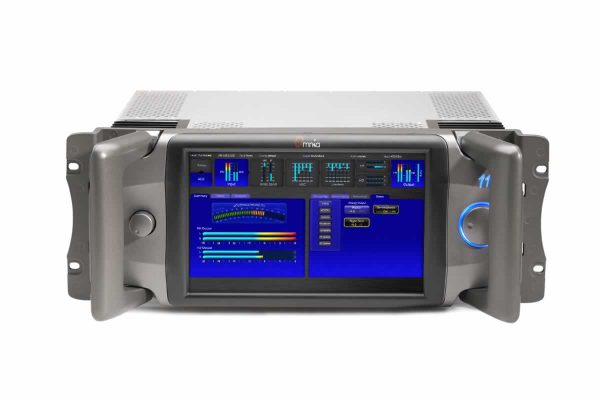
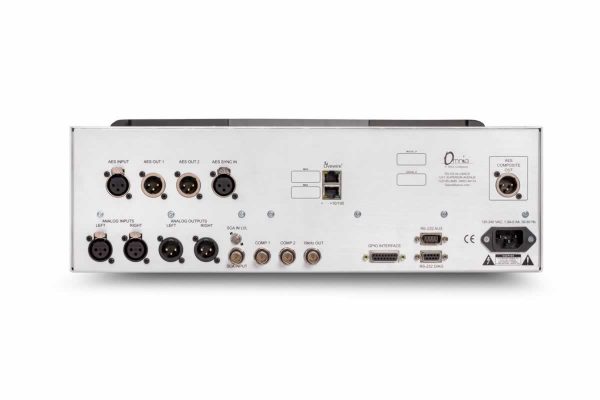
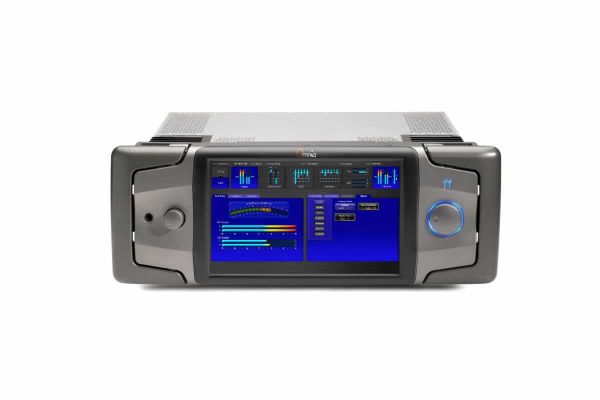
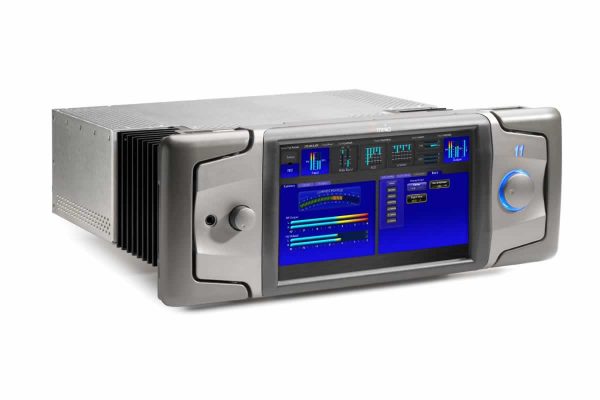
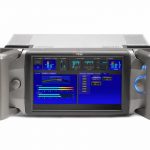
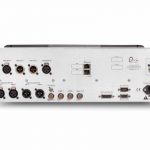
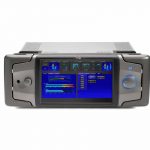
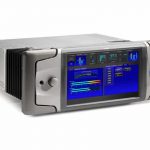
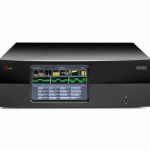
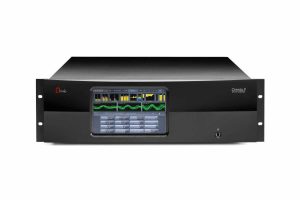
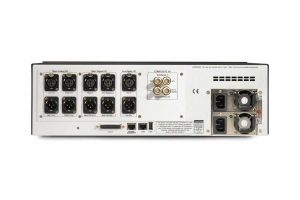
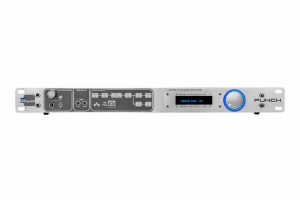
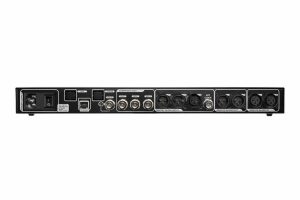
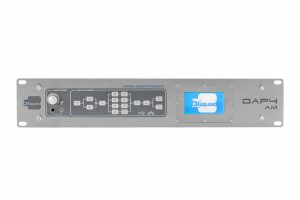
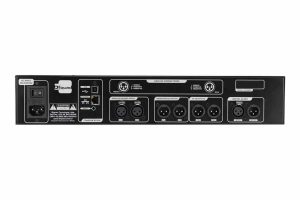
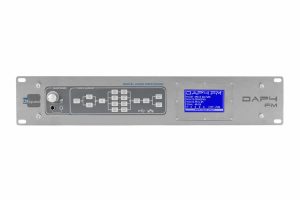
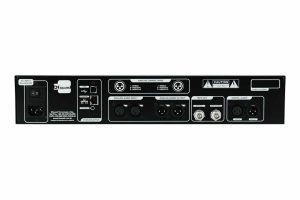
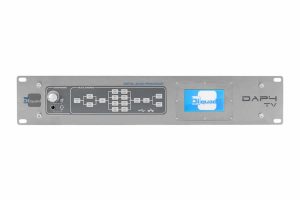
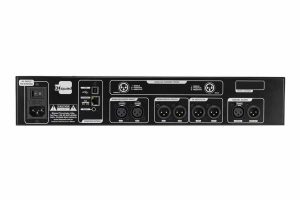
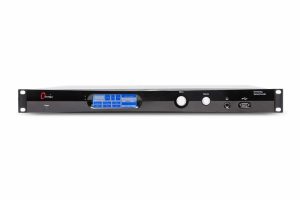
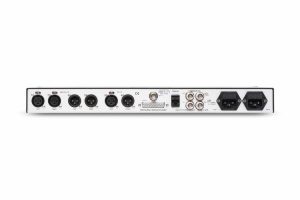


Avaliações
Não há avaliações ainda.